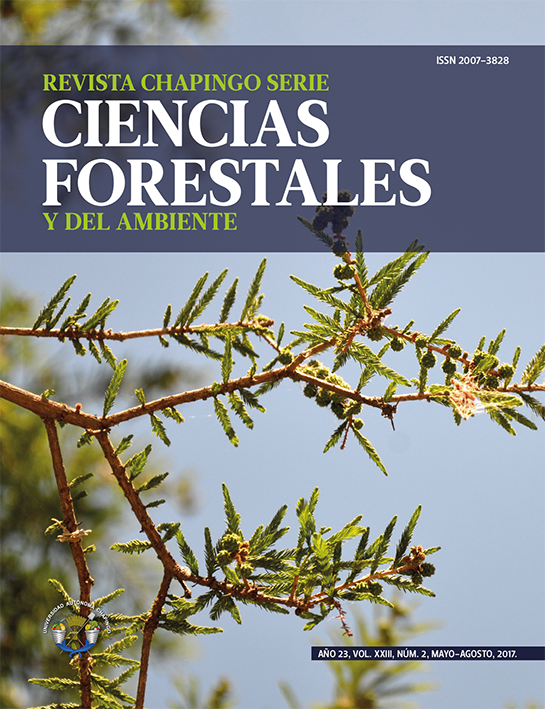Resumen
Introducción: La complejidad del ecotono del límite superior del bosque de Pinus hartwegii puede funcionar como una barrera para la migración altitudinal.
Objetivos: La estructura del bosque de P. hartwegii se caracterizó a través del ecotono de su límite superior en el Nevado de Toluca; además, se determinaron los posibles cambios en los límites altitudinales en los últimos 25 años.
Materiales y métodos: Se determinaron la densidad arbórea, altura y diámetro normal de cada árbol, y la regeneración natural del bosque. Los límites altitudinales se determinaron mediante el método de la ventana móvil en imágenes de satélite de 1989 y 2014.
Resultados y discusión: La densidad del arbolado se redujo entre 8 y 70 % en el gradiente altitudinal. Los límites altitudinales (3,980-4,130 m) no presentaron diferencias significativas (P = 0.07) entre los años evaluados. El ecotono es de forma difusa, regulado por limitaciones al crecimiento. Esto implica que el bosque modificará su distribución altitudinal en función de los cambios ambientales, de acuerdo con su amplitud ecológica y la rapidez con que puedan establecerse nuevos individuos a mayores altitudes.
Conclusión: Es importante establecer monitoreos, a largo plazo, para saber si la especie es realmente capaz de migrar altitudinalmente como resultado del incremento de temperatura ambiental.
Citas
Aitken, N. S., Yeaman, S., Holliday, J. A., Wang, T., & Curtis-McLane, S. (2008). Adaptation, migration or extirpation: Climate change outcomes for tree populations. Evolutionary Applications, 1, 95−111. doi: https://doi.org/10.1111/j.1752-4571.2007.00013.x
Bader, M. Y., Rietkerk, M., & Bregt, A. K. (2007). Vegetation structure and temperature regimes of tropical alpine treelines. Arctic, Antarctic, and Alpine Research, 39, 353−364. doi: https://doi.org/10.1657/1523-0430(06-055)[BADER]2.0.CO;2
Beaman, J. H. (1962). The timberlines of Iztaccíhuatl and Popocatepetl, Mexico. Ecology, 43, 377−385. doi: https://doi.org/10.2307/1933367
Calderón de Rzedowski, G. & Rzedowski, J. (2005). Flora fanerogámica del Valle de México. Michoacán, México: INECOL-CONABIO.
Camarero, J. J., & Fortin, M. J. (2006). Detección cuantitativa de fronteras ecológicas y ecotonos. Ecosistemas, 15, 77−88. http://www.revistaecosistemas.net/index.php/ecosistemas/article/view/164
Camarero, J. J., & Gutiérrez, E. (2004). Pace and pattern of recent treeline dynamics: Response of ecotones to climatic variability in the Spanish Pyrenees. Climatic Change, 63, 181−200. doi: https://doi.org/10.1023/B:CLIM.0000018507.71343.46
Cárdenas, D. I., Martínez, V. M. M., Bravo, I. J. A., Núñez, B. A., & Caballero, G. R. (2008). Manejemos el bosque. La Habana, Cuba: ACTAF.
Challenger, A., & Soberón, J. (2008). Los ecosistemas terrestres. En Comisión Nacional para el Conocimiento y Uso de la Biodiversidad (CONABIO) (Eds.), Capital natural de México, vol. I: Conocimiento actual de la biodiversidad (pp.87−108). México: CONABIO.
Clarck Labs. (2012). IDRISI Selva. Worcester, MA, USA: Clark University.
Coop, J. D., & Givnish, T. J. (2008). Constraints on tree seedling establishment in montane grasslands of the Valles Caldera, New Mexico. Ecology, 89, 1101−1111. doi: https://doi.org/10.1890/06-1333.1
García, E. (1990). Carta de climas, Atlas Nacional de México. México: Universidad Nacional Autónoma de México (UNAM).
González-Rosales, A., & Rodríguez-Trejo, D. A. (2004). Efecto del chamuscado de copa en el crecimiento en diámetro de Pinus hartwegii Lindl. en el Distrito Federal, México. Agrociencia, 38, 537−544. http://www.fire.uni-freiburg.de/GlobalNetworks/MesoAmerica/Research/Chamuscado-Dante.pdf
Harsch, M. A., & Bader, M. Y. (2011). Treeline form - a potential key to understanding treeline dynamics. Global Ecology and Biogeography, 20, 582−596. doi: https://doi.org/10.1111/j.1466-8238.2010.00622.x
Harsch, M. A., Hulme, P. E., McGlone, M. S., & Duncan, R. P. (2009). Are treelines advancing? A global meta-analysis of treeline response to climate warming. Ecology Letters, 12, 1040−1049. doi: https://doi.org/10.1111/j.1461-0248.2009.01355.x
Holtmeier, F. K., & Broll, G. (2005). Sensitivity and response of northern hemisphere altitudinal and polar treelines to environmental change at landscape and local scales. Global Ecology and Biogeography, 14, 395−410. doi: https://doi.org/10.1111/j.1466-822x.2005.00168.x
Iglesias, A. L. G., & Tivo, F. Y. (2006). Caracterización morfométrica de la población de Pinus hartwegii Lindl. del Cofre de Perote, Veracruz, México. Ra Ximhai, 2, 449−468. http://www.revistas.unam.mx/index.php/rxm/article/view/6883
Jobbágy, E. G., & Jackson, R. B. (2000). Global controls of forest line elevation in the northern and southern hemispheres. Global Ecology and Biogeography, 9, 253–268. doi: https://doi.org/10.1046/j.1365-2699.2000.00162.x
Körner, C. (1998). A re-assessment of high elevation treeline positions and their explanation. Oecologia, 115, 445−459. doi: https://doi.org/10.1007/s004420050540
Körner, C., & Paulsen, J. (2004). A world-wide study of high altitude treeline temperatures. Journal of Biogeography, 31, 713−732. doi: https://doi.org/10.1111/j.1365-2699.2003.01043.x
Lauer, W. (1973). The altitudinal belts of the vegetation in the central Mexican highlands and their climatic conditions. Arctic and Alpine Research, 5, A99−A113. http://www.jstor.org/stable/1550159
Lutz, J. A., Larson, A. J., Freund, J. A., Swanson, M. E. & Bible, K. J. (2013). The importance of large-diameter trees to forest structural heterogeneity. PLoS ONE, 812, e82784. doi: https://doi.org/10.1371/journal.pone.0082784
Matteucci, S. D., & Colma, A. (1982). Metodología para el estudio de la vegetación. Washington, DC, USA: Secretaría General de la Organización de los Estados Americanos-Programa Regional de Desarrollo Científico y Tecnológico. https://aprobioma.files.wordpress.com/2011/03/metod_para_el_estudio_de_la_vegetacion_archivo1.pdf
Perry, J. P. Jr. (1991). The pines of Mexico and Central America. Portland, USA: Timber Press.
Ricker, M., Gutiérrez-García, G., & Daly, D. C. (2007). Modeling long-term tree growth curves in response to warming climate: Test cases from a subtropical mountain forest and a tropical rainforest in México. Canadian Journal of Forest Research, 37, 977−989. doi: https://doi.org/10.1139/X06-304
Statistical Analysis System (SAS Institute Inc.). (2008). JMP 8.0, Statistical discovery from SAS. Cary, NC, USA: Author.
Tranquillini, W. (1964). The physiology of plants at high altitudes. Plant Physiology, 15, 345−362. doi: https://doi.org/10.1146/annurev.pp.15.060164.002021
Vera-Vilchis, V., & Rodríguez-Trejo, D. A. (2007). Survival and height increment of Pinus hartwegii two years after prescribed burns and experimental forest fires. Agrociencia, 41, 219−230. http://www.colpos.mx/agrocien/Bimestral/2007/feb-mar/art-9.pdf
Viveros-Viveros, H., Sáenz-Romero, C., Vargas-Hernández, J. J., López-Upton, J., Ramírez-Valverde, G., & Santacruz-Varela, A. (2009). Altitudinal genetic variation in Pinus hartwegii Lindl.: Height growth, shoot phenology and cold damage in seedlings. Forest Ecology and Management, 257, 836−842. doi: https://doi.org/10.1016/j.foreco.2008.10.021
Wong, C. M., & Lertzman, K. P. (2001). Errors in estimating tree age: Implications for studies of stand dynamics. Canadian Journal of Forest Research, 31, 1262−1271. doi: https://doi.org/10.1139/x01-060

Esta obra está bajo una licencia internacional Creative Commons Atribución-NoComercial 4.0.
Derechos de autor 2017 Revista Chapingo Serie Ciencias Forestales y del Ambiente



